
|   |

|   |
The 15th Guru Debaprasad Nritya Parampara Festival - Manjari Sinha e-mail: manjari@sinha.com Photos: Rahul Naag March 13, 2023 Debadhara, the august institution established by Guru Binayak Panda in 2003, imparts training in Odissi dance to promote and preserve the unique style of Guru Debaprasad Das. This gharana has imbibed the essence of the tribal, folk and classical dance forms of Odisha. The aim of Debadhara is to spread the glory of our ancient arts on global stage. To serve this purpose, Debadhara organizes various festivals of Indian dance and music to propagate our rich culture. The 15th edition of their annual Guru Debaprasad Nritya Parampara Festival was held recently at the Godavari auditorium, Delhi. 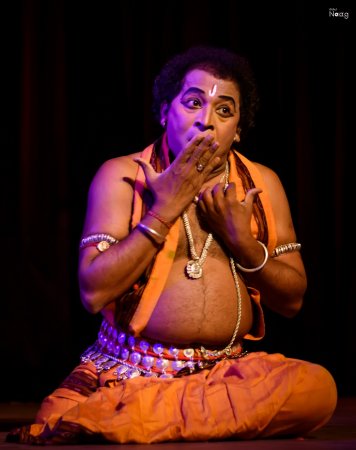 Nityananda Das 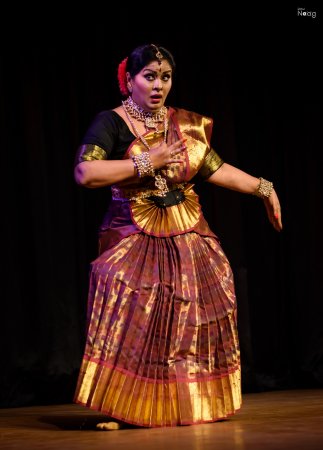 Sudha Chandran The Bharatanatyam and Odissi duet by the Bharatanatyam exponent and actor Sudha Chandran and Odissi Guru Nityananda Das, that gave the two-day festival a flying start, was preceded by their solo numbers on the inaugural evening. Nityananda Das, who has lost his left leg and dances with full gusto on just one, opened with Shiva-stuti in raga Kalawati and then proceeded to "Pangum langhayate girim", taken from the invocatory Sanskrit verse "Mookam karoti vaachalam, Pangum langhayate / Yatkripa tamaham vande, Paramaanand Maadhavam" that translates to, "I bow to Madhava, the abode of infinite joy, who turns the mute into a talkative person, enables the lame one to cross the mountain". The singing of this verse soaked with the pathos of raga Sohini (Hamsanandi), augmented his moving abhinaya, coming from the depth of his innermost feelings. The solo by Sudha Chandran - who lost her right leg in an accident at the age of seventeen but never succumbed to circumstances and carved a niche for herself - opened with the shloka "Neelambuja.....Shriramam namaami" followed by the Tulasidas pada "Shri Ramachandra kripalu bhajmana..." with devotional fervour. The duet Tillana in raga Brindavani Sarang by Nityananda Das and Sudha Chandran in Odissi and Bharatanatyam respectively, got them both a standing ovation. 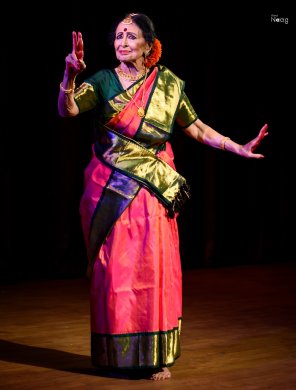 Saroja Vaidyanathan 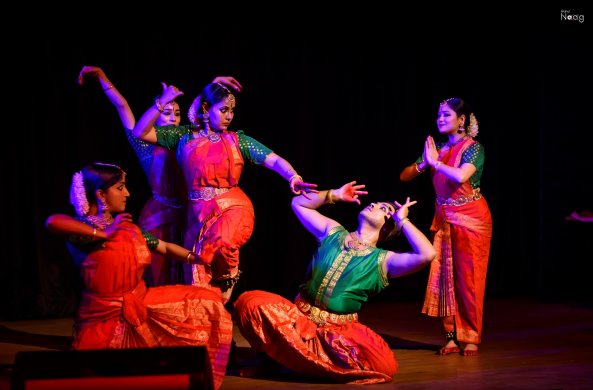 Disciples of Saroja Vaidyanathan Guru Saroja Vaidyanathan and her group's presentation in Bharatanatyam was heralded by the Guru's solo "Om namah Shivaya" on Shiva Panchaakshara Stotram - "Naagendra haraya trilochanaya...," an invocation to Shiva. The five verses opening with each alphabet of the Mantra 'Om Namah Shivaya', were composed in a garland of ragas - Ragamalika opening with raga Yaman and climaxing with Bhairavi. Her well-trained students continued with 'Namaste Astu', a salutation to the limitless, effulgent, all-knowing, all-pervasive, conqueror of death, and the ever auspicious one; an invocation interpreting the attributes of Shiva the Nilakantha, Mrityunjaya, Sarveshwara, Mahadeva, Tripurantaka, invoking him further with the Shiva Tandava Stotram "Jataatavi galajjalat.." interspersed with crisp jathis. An ode to Devi came next as a group choreography on "Aygiri nandini..." incorporating a small tableau of Mahishasura Vadha, concluding with "Sarva mangala maangalye, Shive sarvaartha saadhike". The 'Ardha-Narishwara Stotra' by the great philosopher-poet Adi Shankaracharya was an enthralling visual imagery celebrating the seeming dichotomy of energies coming together to fulfil the crucial cycle of life as Prakriti and Purusha. Composed in ragam Megh, set to adi talam, this was danced solo by Saroja's brilliant disciple Vinay Tiwari with much aplomb. 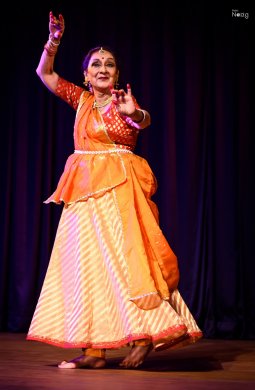 Geetanjali Lal 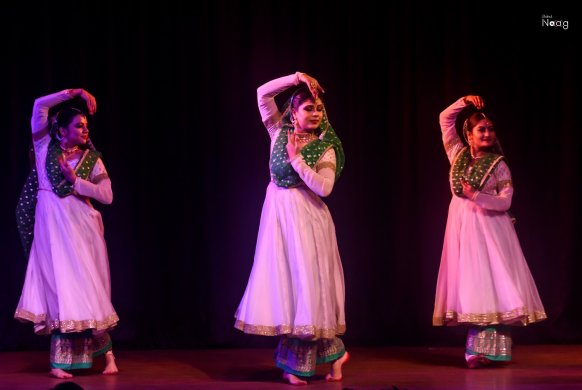 Vidha Lal and disciples Guru Geetanjali Lal and her prime disciple Vidha Lal's Kathak was the concluding presentation of the inaugural evening. Geetanjali Lal, herself trained under stalwarts like Roshan Kumari, Gopi Krishna, Mohanrao Kallianpurkar and Pt. Devilal, is the daughter of the Late Rajnikant Desai, a well-known vocalist of Agra Gharana who trained her in Hindustani classical music as well. Her Kathak, therefore, is known for her musical input. This evening also had this special touch in her solo and group choreographies. 'Krishna Raas', her solo presentation was based on a composition of Vindhya-Vasini Devi "Sharad Yamini, Sang Bhamini, Mohan raas rachaaye", describing the beauty and glory of the 'Sharad-Raas', performed on the festive night of Sharad Purnima. Mesmerized by watching the beautiful Raas Nritya of Krishna-Radha and the Gopikas on the bank of river Yamuna, the full moon of Sharad-Purnima forgets to move and the night gets extended. Geetanjali had composed it herself in raga Jog, sung by Samiullah Khan. No wonder she danced it beautifully. The mood and imagery of monsoon were evoked through 'Varsha Mangal' based on the famous Sur-Malhar bandish of Agra Gharana "Badarawa barasan ko aaye" that Geetanjali had learned from her father. Performed by Vidha and two other students, it was composed and choreographed by Geetanjali Lal using the technical elements of Kathak like footwork synchronized with the falling raindrops, hand gestures, with Tode, Tukde, Parans to show lightning and thunder, and the Kavitt written by Geetanjali herself, describing the ultimate union of Radha and Krishna. Performed by Vidha with Muskan and Anjali Munjal 'Varsha Mangal' got them repeated applause. 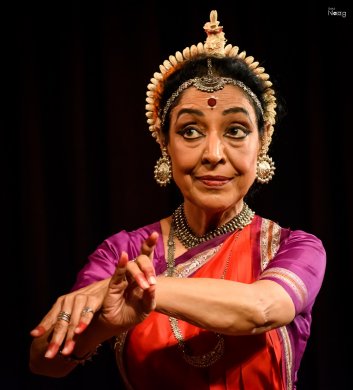 Madhavi Mudgal 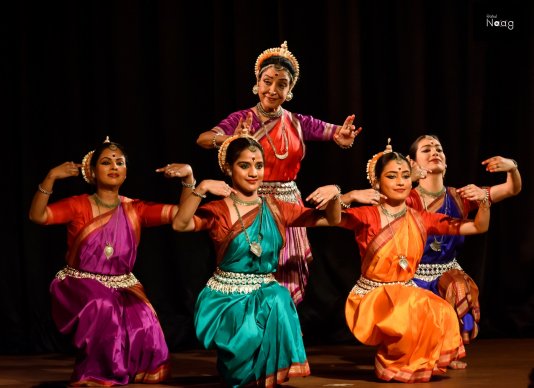 Madhavi Mudgal and disciples The next evening opened with the mesmerizing Odissi recital by Guru Madhavi Mudgal, who is known for her aesthetic approach that brings a refined sensibility to her art. A prime disciple of Guru Kelucharan Mohapatra and the gifted daughter of Pt. Vinay Chandra Maudgalya, her sensitivity towards music and literature is an added asset to her dance works. Madhavi opened her performance with 'Jagannathashtakam', a hymn by Shankaracharya in praise of Jagannath, the Lord of the universe, who resides in the holy city of Puri. Apart from the lyrical interpretation of this invocatory number, her imaginative choreography also had glimpses of the Ratha Yatra of Jagannath, Puri, where the deity is taken out in a procession. The music composed by Sunanda Patnaik seemed to inspire her choreography. The Odia pada of Banamali Das "Dine na dakibu" that Madhavi chose for abhinaya, depicted Radha, who has just discovered the lure of Krishna's divine flute, requesting it not to call her during the day time. Decrying the flute she says, "You, after all, are only a piece of bamboo, which is full of thorns, hence you mercilessly pierce hearts with your melody. If I could snatch you from Krishna's possession, I would smother you in cloth, bury you in sand or perhaps float you down the Yamuna. O Flute, do not call me during the day." Her subtle abhinaya could reach even those who couldn't understand the language. Madhavi also presented Arabhi Pallavi, a visual interpretation of the intangible raga where the musical and rhythmic sequences arranged in aesthetic order created complex patterns to bring out the architectonics of the dance technique. The solo choreography of Guru Kelucharan Mohapatra with music by Pt Bhubaneswar Mishra was adapted here for group choreography by Madhavi Mudgal.  Gajendra Panda Guru Gajendra Panda, a senior representative of the Guru Debaprasad Das Parampara of Odissi, presented Shivashtakam. He is one of those dynamic Gurus who are making significant contributions adding to the Odissi repertoire with his creative inputs of the rich folk traditions of the Ganjam district where he was born and spent his childhood before being groomed under Guru Debaprasad Das. This was proved by his group choreography 'Yogini-Yogarupa' presented by the Debadhara group as the concluding presentation of this festival. 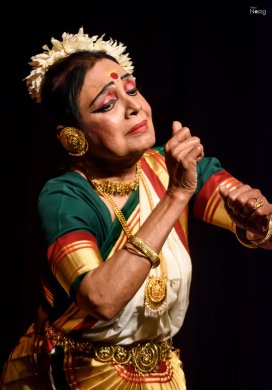 Bharati Shivaji 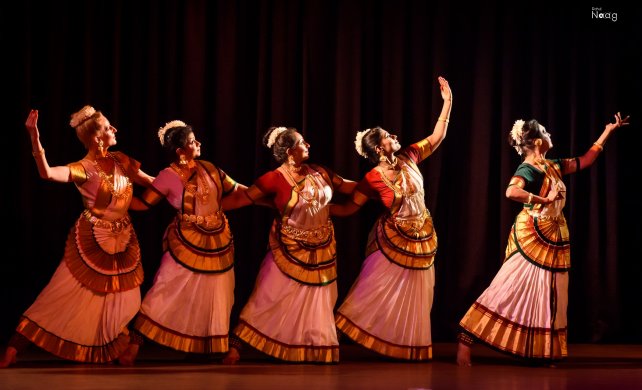 Disciples of Bharati Shivaji Guru Bharati Shivaji, founder/director of the Centre for Mohiniattam, and her disciples presented solo and group choreographies. The group opened with a Thyani, a nritta oriented piece like Mukhachalam as a group and then proceeded to Bharati's solo abhinaya piece on a rare 'Shiva Ashtapadi'. This was written by Bhanu, mentioned in the concluding verse as 'Bhanu-bhanit' for the author's mudra. Here Parwati is depicted as a virahini nayika who is wondering how the flow of her tears feel like the flow of Ganga; is it because the Ganga is flowing from Shiva's matted locks? Why she is feeling feverish with the Kama-Jwara, is it because Shiva had burnt Kamadeva by opening his third eye? And ultimately she realizes it is all happening because Shiva resides in her heart! Bharati's Mohiniattam presentation concluded with Pandattam, the group choreography by her students. 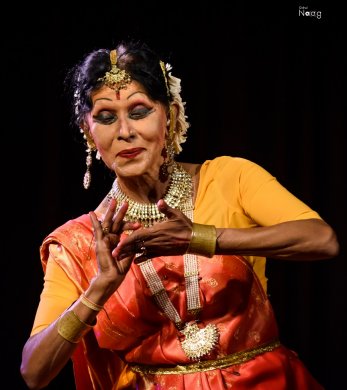 Shovana Narayan 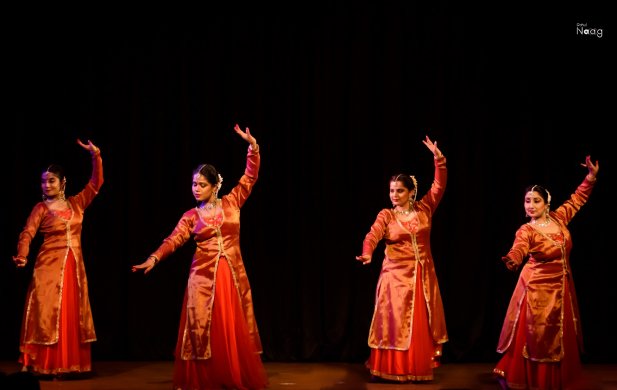 Disciples of Shovana Narayan Kathak Guru Shovana Narayan and her disciples presented 'Traya', underlining the universal power of three through three segments comprising Rudrashtakam underlining devotion, Akanksha, the second part emphasizing romanticism and pragmatism while the third and the final part 'Melody & Rhythm' mirrored the fast pace of life where speed and dynamism rule. Choreographed by Shovana Narayan, 'Traya' was performed by Shovana with her students Komal Biswal, Pallavi Lohani, Suparna Singh and Mahima Satsangi. 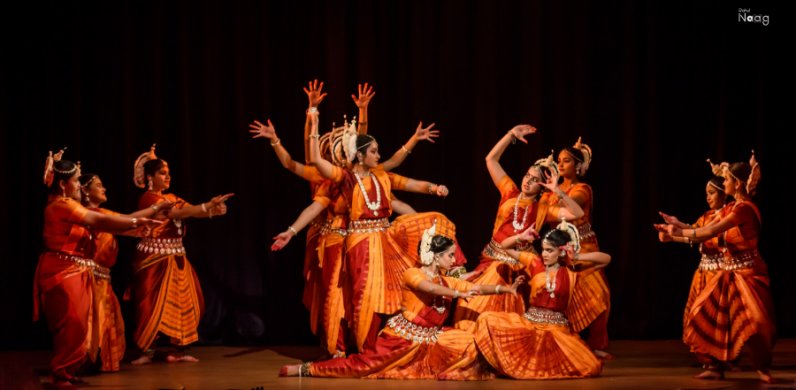 Debadhara group Debadhara group of Guru Binayak Panda concluded the two-day festival with 'Yogini Yogarupa' on the theme of Yogini, their emergence emanating from the divine energy of the Adi Yogi Shiva, seated in an embrace with Mata Parwati at their abode on top of the Himalayas. The multiplication of Yogic energies as Yoginis enact their earthy leela, a celebration of their consequential conjoining with Shiva, the Supreme self. Their leelas touch upon the various local Goddesses worshipped as 'Matri Devatas' or mother Goddess in several names and forms in village shrines. Based on the Goddesses in the Chausath Yogini Temple, Yogini-Yogarupa's music was composed by Guru Gopal Chandra Panda and ukutas (the rhythmic syllables) by late Guru Banamali Maharana, script by Kedar Mishra, and the group choreography by Guru Gajendra Panda, with dancers Ishita Bharati, Eishita Ojha, Rajashree Behera, Mehal Kanoujia, Nishchita Paikaray, Adhya Dubey, Asha Maharana, Adrija Paul, Adisha, Ipshita, Kajal Biswal, Sanchita Paikaray and Amrita Sahoo. 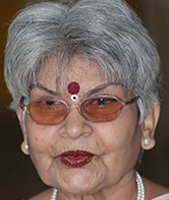 Manjari Sinha has an M.A. in Sanskrit and Music, and trained in vocal, tabla, sitar and Kathak dance. She has regular columns in national dailies as a music and dance critic. |